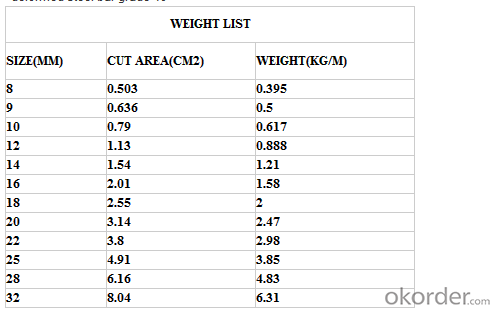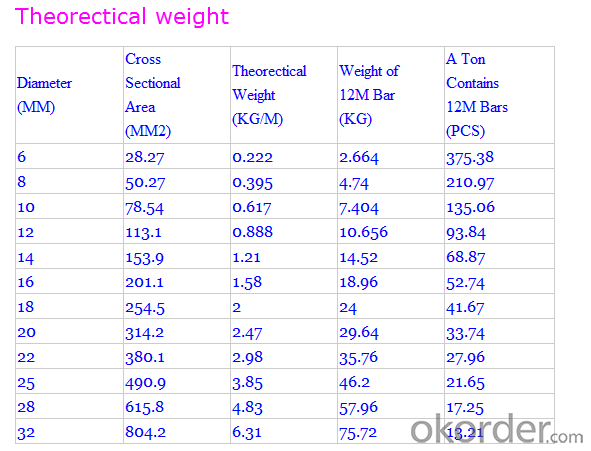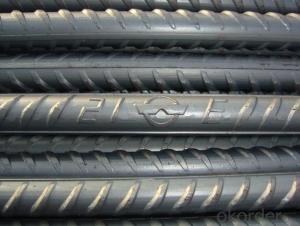Steel Rebar, Deformed Steel Bar, Iron Rods For Construction
- Loading Port:
- Shanghai
- Payment Terms:
- TT OR LC
- Min Order Qty:
- 100 m.t.
- Supply Capability:
- 1000 m.t./month
OKorder Service Pledge
OKorder Financial Service
You Might Also Like
deformed steel bar grade 40
material: HRB400, BS4449 GR460B
size: 8-36mmx12m.
short delivery time by bulk or container
deformed steel bar grade 40
material: HRB400, BS4449 GR460B
size: 8-36mmx12m.
short delivery time with bulk or container
packing: Mill standard export packing in bundles/coil, around 2tons/bundle.
country of Origin: China
delivery Time: Within a 35 days
Shipment: by bulk vessel or by container

Leading goods:
section steel:angles,channels,I-beam,H-beam;
coils:cold/hot rolled coils,PPGI,galvanized coils,plate,checkered plate,cutting steel plate,steel strip;
wire rod:steel wire,deformed wire,bar;
pipe:seamless pipe,rectangular pipe,welded pipe,spiral welded pipe,pipe fittings;
stainless steel:steel sheets,stainless steel strips,stainless bar,stainless tube;
special:weathering steel,shipbuilding steel;
construction steel:C-channel,Z-channel,T-bar,high-speed divider plate,corrugated steel plate,steel grating.
Advantage:
We are the spot supplier, Six huge warehouses which can hold 20,000 MT goods.
It makes the cost lower than others,we can provide the competitive price for you.
Delivery time:
Normal sizes can be provided in 7days, the others should be ready in 30---45 days.
Further treatment:
We can offer cutting,painting,drilling holes,bending,threading, welding,galvanization,packing etc.
Security interest:
We have already passed the ISO9001, BV and SGS authentication which makes the quality secured.
If you have the interest in any of the products we can provided, pls don't hesitate to connect with me. Looking forward to cooperate with you.

FAQ of Steel Deformed Bar
1. More than 10 years experience in this industry
2. 100,000 tons exporting per month
3. Professional foreign trade tea
4. OEM&ODM capacity
5. High quality assured & competitive price
6. Try our best to meet your needs & save your budget
7. Very popular in Southeast Asia, Africa, Mid-East and South America etc.
8. VIP membership system, first time customers and long-term cooperation customers can get extra discount on some products.
- Q:What is the process of testing the quality of steel rebars?
- To ensure compliance with industry standards and specifications, the quality of steel rebars undergoes a series of steps in the testing process. Firstly, visual inspection is conducted to identify any visible defects, such as cracks, irregularities, or improper dimensions. Next, a sample of the rebars is taken for chemical composition analysis. This analysis determines the composition of the steel, including carbon, manganese, sulfur, phosphorus, and other elements, ensuring it meets the required standards for strength and durability. To measure the maximum stress the rebars can endure without deformation or failure, a tensile strength test is performed. This involves applying an increasing load to a sample until it breaks, with the tensile strength calculated by dividing the breaking load by the sample's cross-sectional area. The bend test evaluates the rebar's ductility by bending a sample to a specified angle without any cracks or fractures occurring. This test assesses the rebars' ability to withstand bending and shaping during construction. For rebars intended for use in welded structures, a weldability test is conducted to ensure there are no issues, such as cracking or loss of strength, during the welding process. The rebars are also inspected for dimensional and weight compliance, including length, diameter, and weight. Any deviations from the required specifications may indicate potential quality issues. To assess the rebars' resistance to corrosion over time, a corrosion resistance test is carried out. This involves subjecting the rebars to a corrosive environment or using accelerated corrosion testing methods. Non-destructive testing techniques, such as ultrasonic testing, magnetic particle inspection, or radiographic testing, may be employed to detect any internal defects or irregularities that are not visible to the naked eye. These tests ensure the integrity and quality of the rebars. Once all the tests are completed and the rebars meet the required standards, they are certified and documented. This documentation serves as evidence of the rebars' quality and compliance, ensuring safety and durability in construction projects. By following these comprehensive testing procedures, builders, engineers, and end-users can be assured that the steel rebars meet the necessary quality standards for their intended applications.
- Q:How do steel rebars bond with concrete?
- Steel rebars bond with concrete through a process called mechanical interlock, where the rough surface of the rebar provides better adhesion to the concrete. Additionally, the alkaline environment of the concrete forms a thin layer of iron oxide on the surface of the rebar, which further enhances the bond and prevents corrosion.
- Q:Cast-in-place with 10 mm reinforcement, a good layer or 8 mm double layer? Why?
- Double reinforcement should be adopted for roof bar reinforcement.(5) double deck two-way steel bars shall be installed in cast-in-place slabs with a thickness of more than 120mm.
- Q:What are the guidelines for the proper cover thickness of steel rebars?
- To guarantee the durability and strength of reinforced concrete structures, guidelines have been established to determine the appropriate thickness of steel rebars used in their construction. The term "cover thickness" refers to the distance between the outer surface of the rebar and the concrete edge or surface. The specific guidelines for cover thickness may differ depending on factors such as design requirements, environmental conditions, and the intended purpose of the structure. Nevertheless, there are generally accepted minimum values for cover thickness as outlined in various international building codes and standards. The primary objective of maintaining sufficient cover thickness is to shield the steel rebars from corrosion caused by environmental elements like moisture, carbonation, and chloride ingress. Corrosion can significantly weaken the rebars, compromising the structural integrity of the reinforced concrete. The recommended minimum cover thickness for steel rebars is determined based on the exposure conditions. For instance, in regular environmental conditions, a minimum cover thickness of 25mm to 40mm is usually specified. However, in more aggressive environments, such as coastal areas with high chloride content or structures in contact with soil, a greater cover thickness of 50mm or more may be necessary. Adhering to these guidelines is crucial to ensure the long-term durability and safety of the structure. Insufficient cover thickness can accelerate the corrosion of the rebars, resulting in reduced load-bearing capacity, cracks, and ultimately, structural failure. Therefore, it is essential to consult the relevant building codes, standards, and design professionals to determine the appropriate cover thickness for steel rebars in a specific construction project.
- Q:How do steel rebars prevent cracking in concrete?
- Steel rebars prevent cracking in concrete by providing reinforcement and increasing the overall strength and durability of the structure. When concrete is subject to tensile forces, such as bending or stretching, it tends to crack. However, steel rebars are added to concrete construction to counteract these tensile forces. The rebars, which are made of high-strength steel, are strategically placed within the concrete to create a reinforcing mesh or framework. This mesh acts as a skeleton that absorbs and distributes the tensile forces throughout the concrete structure, preventing the formation of cracks. When external loads, such as heavy weights or seismic forces, are applied to the concrete, the rebars bear the tensile stress instead of the concrete. The steel rebars have a significantly higher tensile strength compared to concrete, allowing them to resist the forces that would normally cause cracking. By distributing the stress more evenly, the rebars minimize the formation of cracks and help maintain the structural integrity of the concrete. Furthermore, steel rebars also prevent cracks by improving the bond between the concrete and the reinforcement. Concrete has excellent compressive strength, but its tensile strength is relatively low. The presence of rebars increases the overall tensile strength of the concrete, making it less likely to crack under tension. The rebars create a bond with the concrete, forming a composite material that can withstand both compressive and tensile forces more effectively. In summary, steel rebars prevent cracking in concrete by providing reinforcement, absorbing tensile forces, and improving the overall strength and durability of the structure. They act as a skeleton within the concrete, distributing stress and preventing the formation of cracks, thereby ensuring the longevity and stability of the concrete construction.
- Q:Are there any limitations or restrictions on using steel rebars in construction?
- Yes, there are certain limitations and restrictions on using steel rebars in construction. Here are some of them: 1. Corrosion: Steel rebars are prone to corrosion when exposed to moisture and certain chemical environments. This can weaken the rebars over time and compromise the structural integrity of the construction. To mitigate this limitation, protective coatings or stainless steel rebars can be used. 2. Fire Resistance: Steel rebars can lose their strength and become malleable when exposed to high temperatures during a fire. This can lead to structural failure. Fireproofing measures such as fire-resistant coatings or using concrete encasement can help enhance the fire resistance of steel rebars. 3. Weight: Steel rebars can be quite heavy, especially for large-scale construction projects. This can pose challenges during transportation, handling, and installation. It may require additional labor or equipment to handle the weight, which can increase project costs. 4. Thermal Expansion: Steel has a relatively high coefficient of thermal expansion, meaning it expands and contracts significantly with temperature changes. This can lead to thermal stresses and potential cracking in the concrete surrounding the rebars. Proper design techniques and the use of expansion joints can help accommodate thermal expansion and mitigate this limitation. 5. Electromagnetic Interference: Steel rebars can interfere with electromagnetic signals, such as those used in communication systems or sensitive electronic equipment. This limitation needs to be considered when constructing buildings with specific requirements, such as hospitals or laboratories. 6. Cost: The cost of steel rebars can fluctuate depending on market conditions, availability, and quality. This can impact the overall budget of construction projects, especially when large quantities of rebars are required. It is important to note that while steel rebars have limitations, they have been widely used in construction due to their strength, durability, and availability. Proper design, construction techniques, and maintenance can help overcome these limitations and ensure the safe and efficient use of steel rebars in buildings and infrastructure.
- Q:How do steel rebars affect the overall cost-effectiveness of a structure?
- Steel rebars can greatly enhance the cost-effectiveness of a structure by providing added strength and durability. Their use reduces the need for excessive concrete, leading to cost savings in material and construction time. Additionally, the longevity and resistance to corrosion offered by steel rebars can result in reduced maintenance and repair expenses over the lifespan of the structure.
- Q:Can steel rebars be used in marine construction?
- Yes, steel rebars can be used in marine construction. They are commonly used as reinforcement in concrete structures to provide strength and durability. However, it is important to use corrosion-resistant steel rebars, such as stainless steel or epoxy-coated rebars, to prevent corrosion due to exposure to saltwater.
- Q:What are the different types of steel rebars used in precast concrete constructions?
- Precast concrete constructions commonly utilize various types of steel rebars to enhance the strength and durability of the structures. The following are some of the commonly employed rebars along with their distinctive features: 1. Mild Steel Rebars: These rebars, widely used due to their affordability and easy availability, possess a low carbon content. They are suitable for most precast concrete applications. 2. High Strength Deformed (HSD) Rebars: HSD rebars, crafted through the hot rolling process, exhibit a superior yield strength compared to mild steel rebars. Their surface is characterized by deformations that enhance their grip with concrete. These rebars are commonly employed in heavy-duty structures or situations necessitating additional strength. 3. Carbon Steel Rebars: Carbon steel rebars, made from carbon steel alloys, possess a higher carbon content than mild steel rebars. Consequently, they offer improved strength and durability. They are often utilized in precast concrete constructions requiring high tensile strength. 4. Epoxy-Coated Rebars: To safeguard against corrosion and extend their lifespan, these rebars are coated with an epoxy layer. Epoxy-coated rebars find common application in precast concrete constructions exposed to harsh environments or possessing high moisture content. 5. Stainless Steel Rebars: Constructed from stainless steel alloys, these rebars exhibit excellent corrosion resistance. They are employed in precast concrete constructions exposed to corrosive substances such as seawater or chemicals. It is crucial to select the appropriate rebar type for a precast concrete construction, considering specific project requirements such as load-bearing capacity, durability, and environmental conditions. Collaborating with a structural engineer or construction professional can aid in determining the most suitable rebar type for a particular application.
- Q:Can steel rebars be used in structures with limited construction technology?
- Yes, steel rebars can be used in structures with limited construction technology. Steel rebars are commonly used as reinforcement in concrete structures to enhance their strength and durability. They are versatile and can be easily incorporated into various construction techniques, making them suitable for structures with limited technology. Additionally, steel rebars offer superior resistance to load and can withstand harsh environmental conditions, ensuring the structural integrity of the building even with limited construction technology.
1. Manufacturer Overview |
|
|---|---|
| Location | |
| Year Established | |
| Annual Output Value | |
| Main Markets | |
| Company Certifications | |
2. Manufacturer Certificates |
|
|---|---|
| a) Certification Name | |
| Range | |
| Reference | |
| Validity Period | |
3. Manufacturer Capability |
|
|---|---|
| a)Trade Capacity | |
| Nearest Port | |
| Export Percentage | |
| No.of Employees in Trade Department | |
| Language Spoken: | |
| b)Factory Information | |
| Factory Size: | |
| No. of Production Lines | |
| Contract Manufacturing | |
| Product Price Range | |
Send your message to us
Steel Rebar, Deformed Steel Bar, Iron Rods For Construction
- Loading Port:
- Shanghai
- Payment Terms:
- TT OR LC
- Min Order Qty:
- 100 m.t.
- Supply Capability:
- 1000 m.t./month
OKorder Service Pledge
OKorder Financial Service
Similar products
New products
Hot products
Related keywords





























